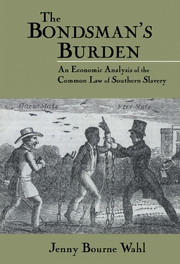Book contents
- Frontmatter
- Contents
- Acknowledgments
- 1 American Slavery and the Path of the Law
- 2 The Law of Sales: Slaves, Animals, and Commodities
- 3 The Law of Hiring and Employment: Slaves, Animals, and Free Persons
- 4 The Law Regarding Common Carriers: Slaves, Animals, Commodities, and Free Persons
- 5 The Law Regarding Governments, Government Officials, Slave Patrollers, and Overseers: Protecting Private Property versus Keeping Public Peace
- 6 The Legal Rights and Responsibilities of Strangers Toward Slaves, Animals, and Free Persons
- 7 Treatment of One's Slaves, Servants, Animals, and Relatives: Legal Boundaries and the Problem of Social Cost
- 8 The South's Law of Slavery: Reflecting the Felt Necessities of the Time
- Notes
- Index
6 - The Legal Rights and Responsibilities of Strangers Toward Slaves, Animals, and Free Persons
Published online by Cambridge University Press: 24 October 2009
- Frontmatter
- Contents
- Acknowledgments
- 1 American Slavery and the Path of the Law
- 2 The Law of Sales: Slaves, Animals, and Commodities
- 3 The Law of Hiring and Employment: Slaves, Animals, and Free Persons
- 4 The Law Regarding Common Carriers: Slaves, Animals, Commodities, and Free Persons
- 5 The Law Regarding Governments, Government Officials, Slave Patrollers, and Overseers: Protecting Private Property versus Keeping Public Peace
- 6 The Legal Rights and Responsibilities of Strangers Toward Slaves, Animals, and Free Persons
- 7 Treatment of One's Slaves, Servants, Animals, and Relatives: Legal Boundaries and the Problem of Social Cost
- 8 The South's Law of Slavery: Reflecting the Felt Necessities of the Time
- Notes
- Index
Summary
The threads of slavery ran seamlessly through the fabric of Southern society. Whether they liked it or not, many antebellum Southerners dealt with slaves on a near-daily basis. Many of these dealings triggered controversy. Public officials, slave patrollers, and common-carrier owners and operators constituted a number of the defendants in cases where strangers injured the interests of slaveowners. But disputes with ordinary citizens and business owners came up as well. As the following sections discuss, four major questions arose: (1) What duty of care did strangers have toward slaves, particularly when protecting other types of property? (2) What recourse did slaveowners have against those who kidnapped slaves and what did masters owe to slave catchers? (3) What penalties were appropriate for those who traded and gamed with slaves, sold liquor to slaves, or otherwise undercut the authority of masters? (4) When should defendants avoid liability (and perhaps recover fees) for treating another's slave well?
In these disputes where interested parties could not cheaply have transacted, people asked judges to allocate liability and damages. Here as elsewhere, slave law typically apportioned risks as people would have done themselves, had they been able to do so easily. Slave law accounted for relevant externalities as well. Because drunken, merchant, or fugitive slaves might have stirred up their compatriots or stolen from whites, slave law imposed stiff penalties on those who sold liquor to or bought goods from blacks, and on those who facilitated slave escapes. And slaveowners had to acquiesce to some discipline of slaves by outsiders and some reward for those who captured fugitives or treated slaves with special care.
- Type
- Chapter
- Information
- The Bondsman's BurdenAn Economic Analysis of the Common Law of Southern Slavery, pp. 120 - 141Publisher: Cambridge University PressPrint publication year: 1997

